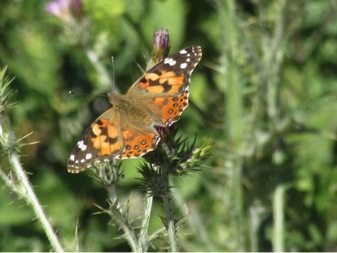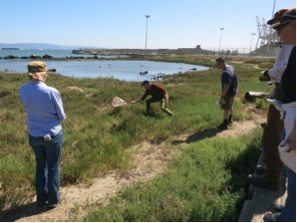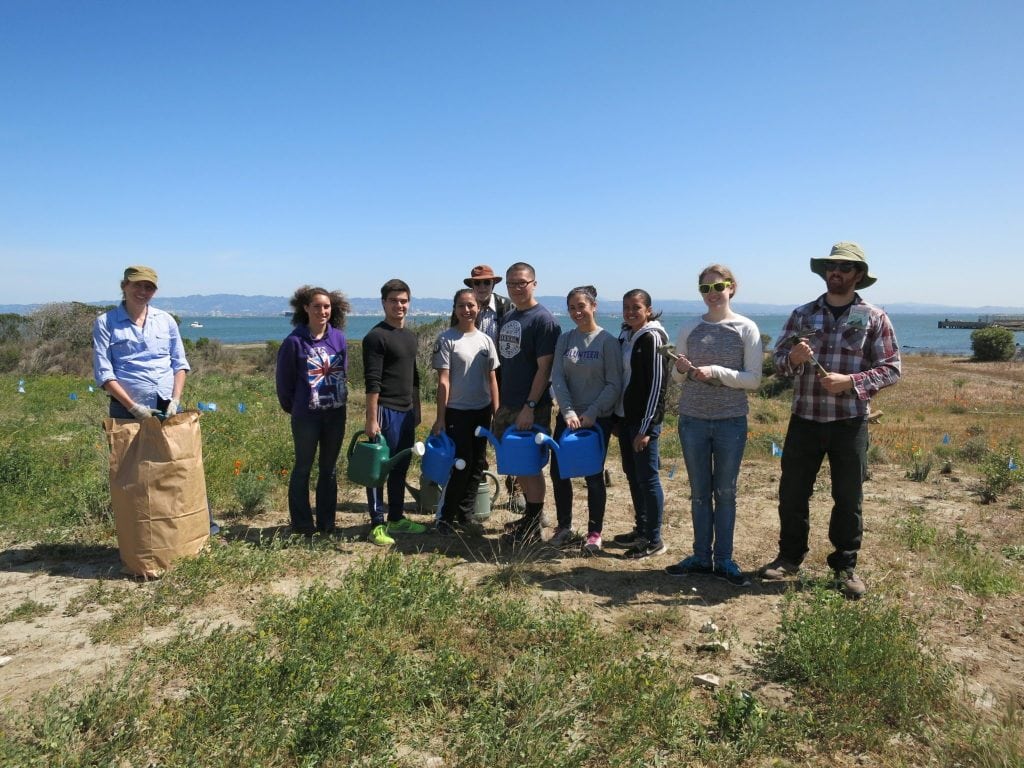Other winged creatures at Pier 94
By Noreen Weeden
If you’re familiar with Golden Gate Bird Alliance, you’ve probably heard about our work restoring Pier 94 as habitat for wildlife on the southeastern San Francisco waterfront. You may have seen photos from our monthly volunteer work days, or you may have read lists of bird sightings there.
But birds aren’t the only winged creatures benefitting from our Pier 94 work!
On Saturday, April 4, we invited Liam O’Brien to join our group of 16 volunteers and introduce them to the butterflies of Pier 94.
Liam is a stage actor who about nine years ago became an enthusiastic and expert lepidopterist. An advocate for San Francisco’s butterflies, he works on the “Tigers on Market Street” project for Nature in the City and was the recipient of Bay Nature magazine’s 2014 Environmental Education Local Hero award.
Liam started by asking the volunteers if butterflies are pollinators. Contrary to many people’s assumptions, the answer is no!
Butterflies do drink nectar from flowering plants and fruit, with a tongue or proboscis that has evolved in length to take advantage of a specific plant. Unlikes bees with their short legs and body designed to efficiently collect, carry, and transfer pollen, butterflies are more like long-legged cranes with bodies that remain far from the pollen.
Rather than a pollinator, the butterfly’s role in its ecosystem is primarily as a food source. Butterflies have a short yet active life of just 10 to 12 days. The female typically lays 80 to 100 eggs. Eighty percent of all butterfly eggs are eaten by creatures crawling on the host plant. Then 80 percent of the larvae and pupae are parasitized by native wasps and flies. (Wasps and flies lay eggs inside the larvae, and the young eat their way out.) Finally, 80 percent of all the adults — the pretty, flying phase when we humans notice them — are eaten by a variety of birds, lizards, and even spiders.
San Francisco has 34 species of butterflies — a manageable number for experienced birders! Two species are specific to the wetlands along the bay and can be seen at Pier 94.

During our April 4 work day, Liam grabbed his net and we followed slowly. The Western pygmy blue (Brephidium exile) butterfly associates with pickleweed. The sandhill skipper (Pilotes sabuleti) depends on salt grass. A sandhill skipper flew by and Liam used the shadow of the net to point to where this small butterfly species had landed in the salt grass.
The group gathered to see the skipper, which had a spread wingspan of about three centimeters and a body less than two centimeters. One swipe of the net and the butterfly was safely captured.


Everyone was able to see the sandhill skipper in the net and then Liam put it on his finger, where it cooperatively posed for a number of photographs. Then, with a gust of wind, it flew back to the edge of the ponds and settled into the salt grass.
Our volunteers collected their tools and gloves and finished watering the 100 native plants they had planted. (They also removed three 30-gallon bags of weeds and two bags of trash!)
Liam walked the Pier 94 site and photographed two more San Francisco species, the Painted Lady and Common Buckeye. We observed a total of 23 birds species that morning at Pier 94.
Come join us at Pier 94 in upcoming months and see what bird and butterfly species show up! Golden Gate Bird Alliance hosts volunteer work days at Pier 94 on the first Saturday of each month, from 9 a.m. to noon. All ages are welcome; no experience necessary. Directions and details are on the Volunteer page of our web site. Thank you to Liam O’Brien for sharing his butterfly knowledge.

